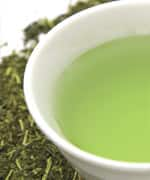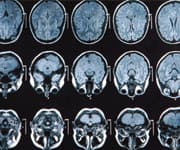Life Extension Magazine®

Green tea is well known for its defense against some of the most common and deadly diseases in America, including cardiovascular disease,1-3 insulin resistance,4 obesity,5-7 autoimmune disorders,8,9 and cancer.10-14
Recent developments have uncovered one of green tea’s most exciting benefits discovered to date: its potential to prevent—and possibly reverse—the effects of Alzheimer’s disease and other forms of dementia.15-19
Alzheimer’s disease occurs as a result of your brain cells being impaired, and eventually killed. This is partially caused by the buildup of toxic protein fragments called amyloid beta.15,16
Green tea gets to the root of Alzheimer’s disease by three distinct mechanisms: preventing the formation of amyloid plaques, breaking down existing plaques, and creating critical new neurons in the brain.
As a result, green tea consumption has now been associated with a 54% reduction in the risk of developing cognitive decline.20
And now, in an exciting development, scientists have used neuroimaging scanning for the first time in a human clinical setting to demonstrate that green tea extract boosts activity in an area of the brain specifically used for working memory.19
How Alzheimer’s Disease Occurs

Alzheimer’s disease is the sixth leading cause of death in America and the fifth leading cause of death in those 65 or older.21 A shocking one in three seniors dies with Alzheimer’s or another form of dementia.21 Experts have recently predicted that the number of people living with dementia will nearly triple by 2050.22,23
Alzheimer’s disease is a progressive, devastating, and eventually fatal neurodegenerative brain disorder.24,25 It is caused when tightly bound protein sheets known as amyloid plaques slowly form in the brain. These plaques eventually create neuronal damage and loss. Then, deprived of their oxygen supply, brain cells begin to die.26 Eventually, the result is memory and speech loss,27 diminished motor skills,28 and ultimately—death.29
Amyloids are a complex of stable misfolded proteins, and no current drug therapies have been able to halt or reverse their deadly impact on the central nervous system.30,31 There are five drugs approved for Alzheimer’s, but they only partially treat some of the symptoms and only temporarily—for about six to 12 months—and only for about half of the patients who take them.32 That’s not a promising track record for these expensive pharmaceutical drugs.33
Given this obvious void in either treating or preventing Alzheimer’s, scientists have continued searching for natural interventions that would battle the disease at its root: by inhibiting the formation and accumulation of the amyloid plaques and blocking them from being toxic.
Scientists have found that green tea has three distinct actions that reduce neurodegeneration and protect against Alzheimer’s by:
- Preventing formation of amyloid plaques that are characteristic of Alzheimer’s disease,34
- Breaking down existing amyloid plaques by disrupting early-stage and late-stage aggregation processes,15 and
- Promoting the production of new neurons (neurogenesis) in the adult hippocampus, the area of the brain responsible for converting memories from short-term to long-term.35
Green Tea’s Dramatic Impact On Neurodegeneration
Green tea (Camellia sinensis) contains catechins, which are naturally occurring, multifunctional compounds that have been found to have potent neuroprotective effects.36,37 Specifically, the powerful green tea catechin epigallocatechin-3-gallate ( EGCG) has been found to lessen cognitive impairments induced by psychological stress in rodent research,38 which suggests its potential to be an effective protector of brain neurons.39 EGCG has been shown to cross the blood-brain barrier in mammals.40,41
Laboratory investigations have revealed that—unlike other flavonoids—green tea compounds are able to reduce neurodegeneration.
When the catechins in green tea were scientifically tested in a wide array of cellular models of neurological diseases, they exhibited dramatic iron-chelating, free-radical-scavenging, and anti-inflammatory activities.42 They were also neuroprotective in models of both Alzheimer’s and Parkinson’s disease.43
Further investigation of these promising compounds showed that they enhanced gene modulating and cell-signaling activities,42 favorably increased detoxifying enzymes and antioxidant enzymes,44,45 and protected DNA against oxidative damage.46
Combating The Underlying Factors Of Alzheimer’s
Green tea compounds have demonstrated additional actions on the factors involved in the development of Alzheimer’s disease.
Studies on brain hippocampal cells of rats showed that green tea extract inhibited the formation of amyloid-beta fibrils, or fine fibers. This was a crucial finding because these amyloid fibrils are implicated in neuron death41 and Alzheimer’s-related cognitive symptoms.47
Amyloid-beta fragments (fibrils) require copper, iron, or zinc to aggregate into stable plaques.48,49 A 2013 study in the Proceedings of the National Academy of Sciences found that EGCG interfered with pathways involved in the binding of copper and zinc to amyloid-beta fragments, thus preventing the formation of larger, stable amyloid plaques.15
A 2010 study, documented in the Proceedings of the National Academy of Sciences, determined that the way EGCG stops the accumulation of amyloid-beta is by transforming amyloid fibrils into shapes that are stable and not toxic to cells.16,50 Sticky and toxic amyloid aggregates of varying shapes adhere to neurons by attaching themselves to misfolded proteins called prions on the cells’ surfaces. The study found that EGCG changed the shapes of these amyloid fibrils so they could no longer bind to the prions.16
Once research determined the effect green tea had on the underlying factors involved in the process of developing Alzheimer’s disease, scientists set out to determine if green tea compounds would block actual neurodegeneration in experimental animals and—more importantly—in healthy humans.
What You Need To Know
 |
Green Tea Extract Battles Alzheimer’s Disease
- Amyloid-beta accumulates in the brain and occupies, and often kills, nerve cells—resulting in Alzheimer’s disease, the sixth leading cause of death in the US.
- A growing body of compelling evidence demonstrates that green tea extract greatly reduces the risk of Alzheimer’s and other forms of dementia.
- Researchers found that the potent green tea compound EGCG prevents amyloid plaque buildup, breaks down existing amyloid plaques, and triggers production of new neurons in the adult hippocampus.
- In an exciting breakthrough, scientists have used MRI scanning in a human clinical setting to watch in real time the immediate boost in working-memory activity that green tea extract produces—confirming the potent neuroprotection of green tea molecules.
Green Tea Improves Age-Related Memory Problems
Amyloid-beta plaques affect rodent brains similarly to human brains in that the accumulation of amyloid-beta quickly leads to the development of Alzheimer’s-like memory problems.51,52 This makes them especially valuable in Alzheimer’s research.
Scientists administered EGCG into a group of mice with simulated aging to determine its effect on age-related memory loss.53 For this study, researchers divided healthy male and female mice into four groups: The first group received D-galactose (a type of sugar that causes accelerated aging,54 but no EGCG); the second and third groups received D-galactose plus two different doses of EGCG; the fourth group received a placebo.53
As expected, the group injected with D-galactose—but not with EGCG—showed learning and memory impairment in a water maze test, compared to non-aged controls. This was not surprising considering similar impairment occurs in aging humans and Alzheimer’s patients. In this aging-induced group, researchers also observed decreased activities of two powerful antioxidants, total superoxide dismutase (T-SOD) and glutathione peroxidase (GSH-Px). And in the hippocampus, they noted increased levels of malondialdehyde (MDA), a dangerous marker for oxidative stress. Cell death, or apoptosis, was also increased.53
The two groups that were injected with both D-galactose and EGCG showed almost the opposite response of the D-galactose-only group. These groups experienced marked improvement in memory and learning deficits, elevated T-SOD and GSH-Px activities, decreased MDA contents in the hippocampus, and reduced cell apoptosis. The researchers concluded: “ The results suggest that EGCG has potent neuroprotective effects on aging mice.”53
Green Tea—A Wide Range Of Health Dividends
 |
Although tea comes in many varieties, evidence suggests that the healthiest choice may be green tea, due to its high concentration of powerful polyphenols.
Beneficial polyphenols make up roughly 30 to 40% of green tea, as opposed to only 3 to 10% of black tea. The polyphenols in tea are classified as catechins, and of the eight catechins in green tea, epigallocatechin-3-gallate, or EGCG, is the most active.60
Green tea catechins scavenge oxygen-free radicals, restoring cells to health and reducing inflammation. Because inflammation underlies so many age-related afflictions, green tea may have a myriad of applications in preventing disease.61,62
Findings from animal studies suggest that green tea polyphenols promote the repair of damaged DNA. Since DNA damage can lead to cancer, green tea may play an important role in preventing cancer.63
The EGCG in green tea has been shown to produce apoptosis (cell death) in experimental prostate cancer, inhibit the growth of squamous cell carcinomas of the head and neck, inhibit the production and limit the invasion of experimentally induced breast cancers, reduce the incidence of carcinogen-induced lung cancers, and sensitize melanoma cells to growth inhibition by other agents.10-14,64
Green tea is also well-known to provide substantial defense against an array of diseases, including cardiovascular,1-3 insulin resistance,4 obesity,5-7 and autoimmune.8,9
High-quality extracts are available that provide green tea compounds standardized to 45% EGCG and 98% polyphenols so individuals can derive the maximum benefit from green tea without having to drink numerous cups of tea each day.
Green Tea Gets To The Root Of Alzheimer’s
This finding indicated that EGCG provides neurons with strong protection against the cognitive and memory impairments associated with aging. Scientists next wanted to determine if these effects occurred as a result of inhibiting the accumulation of amyloid plaques.
So in late 2013, researchers in China reporting in the journal Molecular Neurobiology, conducted a similar experiment—this time focusing specifically on the effects of EGCG on amyloid.55
In order to test this, investigators administered EGCG daily to age-matched, male and female APP/PS1 mice.55 (APP/PS1 transgenic mice are those that are genetically inclined to increased expression of amyloid precursor protein and amyloid-beta. They imitate the physical and behavioral changes of Alzheimer’s disease and have early-onset Alzheimer’s, and to a more intense degree, amyloid plaque buildup.)
As in the previous study, behavioral tests demonstrated that EGCG treatment had improved learning and memory impairment in the APP/PS1 mice, reduced the death of brain neurons, and significantly reduced hippocampal neurodegeneration after four weeks. However, this time scientists determined that EGCG also dramatically reduced the levels of amyloid precursor protein and reduced the buildup of amyloid-beta plaques in the hippocampus.55
Together, these impressive findings answered the question as to whether EGCG can block the accumulation of amyloid-beta plaques and other factors associated with the development of Alzheimer’s disease symptoms.
But Chinese researchers posed another extremely tantalizing question: If EGCG can prevent changes associated with the death of hippocampal neurons in the development of Alzheimer’s, could it also trigger the production of new hippocampal neurons—in effect reversing the effects of this disease?
Shockingly, the answer is yes.
How Green Tea Protects The Brain
 |
EGCG is the most potent neuroprotective compound in green tea, as well as its most abundant polyphenol.60
Initially, researchers wondered if green tea’s beneficial effects on the brain occurred as a result of its antioxidant activity.65 Although free-radical quenching may indeed play a part, a wealth of studies finally determined that EGCG’s antioxidant activity could not fully explain its broad and powerful neuroprotective effects.66
Scientists now realize that EGCG’s neuroprotection works through multiple higher-level mechanisms. Through a significant number of in vitro studies, it appears that EGCG protects the brain via at least nine mechanisms:
- It interferes with the assembly of amyloid-beta proteins.67
- It inhibits the formation of amyloid-beta fibrils, halting their aggregation to plaques.41
- It prevents the proper binding of copper and zinc, which is required for the creation of stable amyloid-beta plaques.15
- It changes the shape of amyloid fibrils, preventing them from binding to neuronal prions16 and transforming them into shapes that are not toxic to neurons.68
- It inhibits the toxicity to neurons that would otherwise be induced by hydrogen peroxide69 and amyloid-beta.34,69-72
- It prevents mitochondrial dysfunction, usually induced by amyloid-beta in brain cells.73
- It normalizes responses of brain cells to an excitatory neurotransmitter (NMDA).74
- It down-regulates pro-apoptotic genes.66
- It up-regulates kinase enzymes, such as protein kinase C.72
Reverse The Effects Of Alzheimer’s Disease
The production of new adult neurons, a process called neurogenesis, is the key feature of brain plasticity, which is critical to brain function as we age.17
Producing new adult neurons in the hippocampus (the part of the brain that converts information from short-term to long-term memory56) may serve as a new treatment strategy for early stage Alzheimer’s or other forms of dementia.57 That’s why scientists focused their attention on the effects of EGCG on neurogenesis in this specific area of the mouse brain.17
Amazingly, both the in vitro and in vivo results of this study showed that EGCG boosts the production of neural progenitor cells, which are brain cells that can transform into various types of neural cells.17,58
In order to determine if this increased brain-cell production would result in a direct boost in memory or spatial learning, the researchers gave one group of lab mice EGCG from green tea, while the other group was given a placebo containing no EGCG. The mice were subsequently trained for seven days to find a hidden platform.
The mice that were administered EGCG found the hidden platform substantially faster—indicating that EGCG’s ability to enhance the production of new adult neurons had directly boosted learning and memory by improving object recognition and spatial memory.17
What’s remarkable is that EGCG promotes the production of new neurons in the same area of the brain in which neurons are killed during the development of Alzheimer’s disease!
This study offers an exciting look into the potential to not only prevent—but reverse—the effects of Alzheimer’s disease in the brain.
However, the real challenge was whether this effective green tea compound would deliver the same preventive effect to healthy humans.
Live Images Reveal Immediate Memory Enhancement

Data about the consumption of black, oolong, or green tea and cognitive function was obtained and examined for over 1,000 Japanese subjects age 70 or over during a period of four months. Analysis of the data revealed that consumption of 2 or more cups per day of green tea reduced the odds of cognitive impairment by 54%, whereas those that consumed equal amounts of black or oolong tea had an odds reduction of only 13%.20
However, this was a cross-sectional study that did not provide hard scientific evidence of effectiveness. To achieve more definitive results, scientists use double-blind, placebo-controlled studies. Unfortunately, it is extremely difficult to conduct intervention studies that would continually monitor human volunteers for adherence and allow for the time required to sufficiently establish, through memory tests, whether green tea enhances memory and recall.
But in a recent study published in the European Journal of Clinical Nutrition, scientists performed the first neuroimaging study allowing them to see the real-time effects of green tea extract inside the human brain’s working-memory area!19
On four separate occasions, with a one-week interval between sessions, healthy volunteers between 21 and 28 years old consumed either a placebo drink, a 250 mL, or a 500 mL combination drink containing green tea extract. The researchers used a feeding tube to rule out taste as a factor.
After consuming the drink, the subjects then performed a memory-stimulating task while researchers simultaneously monitored their brain function using functional magnetic resonance imaging, or fMRI, to zero-in on the working-memory region.
Thanks to this imaging technique, rather than relying on possibly imperceptible differences in performance on a brief memory test following a single dose or even a week of supplementation—scientists could watch the volunteers’ working memories in action on a second-by-second basis.
Compared to placebo, the beverages containing green tea extract significantly boosted activity in the dorsolateral prefrontal cortex—the area of the brain used for working-memory processing.19,59 This small region allows the brain to simultaneously store and process information, and it facilitates complex cognitive tasks, such as language comprehension, reasoning, and learning.
Activity in this memory area was increased even further by the higher dose drink.19 This dose-related response backs up the cause-and-effect connection between green tea and improved memory processing.
Not only did this finding confirm green tea extract’s immediate and significant enhancement of working-memory activity, the researchers noted that it also established for the first time the effectiveness of neuroimaging in observing green tea’s instant impact on the human brain.19
Taken together, all of these findings indicate green tea extract’s marked protection of brain neurons by inhibiting the formation of amyloid-beta fibrils and other processes associated with Alzheimer’s disease and, possibly, by triggering the production of new brain neurons.
Summary
Amyloid-beta plaques slowly form in the brain and interfere with nerve cells, often killing them. The tragic result too often is Alzheimer’s disease—the sixth leading cause of American deaths.
Accumulating evidence demonstrates that green tea extract may reduce the risk of Alzheimer’s disease and other forms of cognitive decline by 54%.
Studies show that the powerful green tea compound EGCG prevents formation of amyloid plaques, breaks down existing amyloid plaques,and promotes production of new neurons in the adult hippocampus.
In an exciting development, scientists used MRI scanning for the first time in a human clinical setting to watch the immediate boost in working-memory activity that green tea extract produces—illustrating in real-time the potent neuroprotection of green tea compounds.
If you have any questions on the scientific content of this article, please call a Life Extension® Health Advisor at 1-866-864-3027.
References
- Lin JK, Lin-Shiau SY. Mechanisms of hypolipidemic and anti-obesity effects of tea and tea polyphenols. Mol Nutr Food Res. 2006 Feb; 50(2):211-7.
- Riemersma RA, Rice-Evans CA, Tyrrell RM, Clifford MN, Lean ME. Tea flavonoids and cardiovascular health. QJM. 2001 May; 94(5):277-82.
- Kuriyama S, Shimazu T, Ohmori K, et al. Green tea consumption and mortality due to cardiovascular disease, cancer, and all causes in Japan: the Ohsaki study. JAMA. 2006 Sep 13; 296(10):1255-65.
- Wu LY, Juan CC, Hwang LS, Hsu YP, Ho PH, Ho LT. Green tea supplementation ameliorates insulin resistance and increases glucose transporter IV content in a fructose-fed rat model. Eur J Nutr. 2004 Apr; 43(2):116-24.
- Wolfram S, Wang Y, Thielecke F. Anti-obesity effects of green tea: from bedside to bench. Mol Nutr Food Res. 2006 Feb; 50(2):176-87.
- Dulloo AG, Duret C, Rohrer D, et al. Efficacy of a green tea extract rich in catechin polyphenols and caffeine in increasing 24-h energy expenditure and fat oxidation in humans. Am J Clin Nutr. 1999 Dec; 70(6):1040-5.
- Chantre P, Lairon D. Recent findings of green tea extract AR25 (Exolise) and its activity for the treatment of obesity. Phytomedicine. 2002 Jan; 9(1):3-8.
- Hsu S, Dickinson D. A new approach to managing oral manifestations of Sjogren’s syndrome and skin manifestations of lupus. J Biochem Mol Biol. 2006 May 31; 39(3):229-39.
- Hsu S, Dickinson DP, Qin H, et al. Inhibition of autoantigen expression by (-)-epigallocatechin-3-gallate (the major constituent of green tea) in normal human cells. J Pharmacol Exp Ther. 2005 Nov; 315(2):805-11.
- Siddiqui IA, Shukla Y, Adhami VM, et al. Suppression of NFkappaB and its regulated gene products by oral administration of green tea polyphenols in an autochthonous mouse prostate cancer model. Pharm Res. 2008 Sep; 25(9):2135-42.
- Amin AR, Khuri FR, Chen ZG, Shin DM. Synergistic growth inhibition of squamous cell carcinoma of the head and neck by erlotinib and epigallocatechin-3-gallate: the role of p53-dependent inhibition of nuclear factor-kappaB. Cancer Prev Res (Phila). 2009 Jun; 2(6):538-45.
- Nihal M, Ahsan H, Siddiqui IA, Mukhtar H, Ahmad N, Wood GS. (-)-Epigallocatechin-3-gallate (EGCG) sensitizes melanoma cells to interferon induced growth inhibition in a mouse model of human melanoma. Cell Cycle. 2009 Jul 1; 8(13):2057-63.
- Sen T, Moulik S, Dutta A, et al. Multifunctional effect of epigallocatechin-3-gallate (EGCG) in downregulation of gelatinase-A (MMP-2) in human breast cancer cell line MCF-7. Life Sci. 2009 Feb 13; 84(7-8):194-204.
- Roy P, Nigam N, Singh M, et al. Tea polyphenols inhibit cyclooxygenase-2 expression and block activation of nuclear factor-kappa B and Akt in diethylnitrosoamine induced lung tumors in Swiss mice. Invest New Drugs. 2010 Aug; 28(4):466-71.
- Hyung SJ, DeToma AS, Brender JR, et al. Insights into antiamyloidogenic properties of the green tea extract (-)-epigallocatechin-3-gallate toward metal-associated amyloid-beta species. Proc Natl Acad Sci USA. 2013 Mar 5; 110(10):3743-8.
- Rushworth JV, Griffiths HH, Watt NT, Hooper NM. Prion protein-mediated toxicity of amyloid-beta oligomers requires lipid rafts and the transmembrane LRP1. J Biol Chem. 2013 Mar 29; 288(13):8935-51.
- Wang Y, Li M, Xu X, Song M, Tao H, Bai Y. Green tea epigallocatechin-3-gallate (EGCG) promotes neural progenitor cell proliferation and sonic hedgehog pathway activation during adult hippocampal neurogenesis. Mol Nutr Food Res. 2012 Aug;56(8):1292-303.
- Tomata Y, Kakizaki M, Nakaya N, et al. Green tea consumption and the risk of incident functional disability in elderly Japanese: the Ohsaki Cohort 2006 Study. Am J Clin Nutr. 2012 Mar; 95(3):732-9.
- Borgwardt S, Hammann F, Scheffler K, Kreuter M, Drewe J, Beglinger C. Neural effects of green tea extract on dorsolateral prefrontal cortex. Eur J Clin Nutr. 2012 Nov;66(11):1187-92.
- Kuriyama S, Hozawa A, Ohmori K, Shimazu T, Matsui T, Ebihara S, Awata S, Nagatomi R, Arai H, Tsuji I. Green tea consumption and cognitive function: a cross-sectional study from the Tsurugaya Project 1. Am J Clin Nutr. 2006 Feb;83(2):355-61.
- Available at: http://www.alz.org/alzheimers_disease_facts_and_figures.asp. Accessed May 23, 2014.
- Available at: http://www.alz.co.uk/research/world-report-2013. Alzheimer’s Disease International. World Alzheimer Report 2013. Journey of Caring: An analysis of long-term care for dementia. Accessed May 23, 2014.
- Available at: http://www.medicaldaily.com/dementia-cases-triple-2050-how-medical-advancements-boost-risk-demographics-developing-countries . Accessed May 23, 2014.
- Ho L, Sharma N, Blackman L, Festa E, Reddy G, Pasinetti GM. From proteomics to biomarker discovery in Alzheimer’s disease. Brain Res Brain Res Rev . 2005 Apr;48(2):360-9.
- Hardy J, Allsop D. Amyloid deposition as the central event in the aetiology of Alzheimer’s Disease. Trends Pharmacol Sci. 1991;12(10):383-88.
- Ibegbu AO, McBean D, Fyfe L, Mullaney I. Morphological changes induced by opioid receptor agonist treatment of B50 neuronal cells cultured in hypoxia. Journal of Morphological Sciences.2013; 30(4), 219-227.
- Ferris SH, Farlow M. Language impairment in Alzheimer’s disease and benefits of acetylcholinesterase inhibitors. Clin Interv Aging. 2013;8:1007-14.
- Zidan M, Arcoverde C, Bom de Araujo N, Vasques P, Rios A, Laks J, Deslandes A. Motor and functional changes in different stages of Alzheimer’s disease. Rev Psiq Clín. 2012;39(5):161-5
- Cotman CW, Su JH. Mechanisms of neuronal death in Alzheimer’s disease. Brain Pathol. 1996 Oct;6(4):493-506.
- Lemkul JA, Bevan DR. Assessing the stability of Alzheimer’s amyloid protofibrils using molecular dynamics. J Phys Chem B. 2010 Feb 4;114(4):1652-60.
- Citron M. Alzheimer’s disease: strategies for disease modification. Nat Rev Drug Discov. 2010 May 9:387-98.
- Available at: http://www.alz.org/research/science/alzheimers_disease_treatments.asp. Accessed May 23, 2014.
- Casey DA, Antimisiaris D, O’Brien J. Drugs for Alzheimer’s disease: Are they effective? P&T. 2010;35(4):208-11.
- Rezai-Zadeh K, Shytle D, Sun N, Mori T, Hou H, Jeanniton D, Ehrhart J, Townsend K, Zeng J, Morgan D, Hardy J, Town T, Tan J. Green tea epigallocatechin-3-gallate (EGCG) modulates amyloid precursor protein cleavage and reduces cerebral amyloidosis in Alzheimer transgenic mice. J Neurosci. 2005 Sep 21;25(38):8807-14.
- Preston AR, Shohamy D, Tamminga CA, Wagner AD. Hippocampal function, declarative memory, and schizophrenia: anatomic and functional neuroimaging considerations. Curr Neuro Neurosci Rep. 2005;5:249–56.
- Commenges D, Scotet V, Renaud S, Jacqmin-Gadda H, Barberger-Gateau P, Dartigues JF. Intake of flavonoids and risk of dementia. Eur J Epidemiol. 2000;16:357-63.
- Kakuda T. Neuroprotective effects of the green tea components theanine and catechins. Biol Pharm Bull. 2002 Dec;25(12):1513-8.
- Chen WQ, Zhao XL, Wang DL, et al. Effects of epigallocatechin-3-gallate on behavioral impairments induced by psychological stress in rats. Exp Biol Med (Maywood). 2010;12(5):577-83.
- Lee SY, Kim CY, Lee JJ, et al. Effects of delayed administration of (-)-epigallocatechin gallate, a green tea polyphenol on the changes in polyamine levels and neuronal damage after transient forebrain ischemia in gerbils. Brain Res Bull 2003;61:399-406.
- Suganuma M, Okabe S, Oniyama M, Tada Y, Ito H, Fujiki H. Wide distribution of [3H](-)-epigallocatechin gallate, a cancer preventive tea polyphenol, in mouse tissue. Carcinogenesis. 1998;19:1771-6.
- Bastianetto S, Yao ZX, Papadopoulos V, Quirion R. Neuroprotective effects of green and black teas and their catechin gallate esters against beta-amyloid-induced toxicity. Eur J Neurosci. 2006;23:55-64.
- Mandel SA, Avramovich-Tirosh Y, Reznichenko L, et al. Multifunctional activities of green tea catechins in neuroprotection. Modulation of cell survival genes, iron-dependent oxidative stress and PKC signaling pathway. Neurosignals. 2005;14:46-60.
- Weinreb O, Mandel S, Amit T, Youdim MB. Neurological mechanisms of green tea polyphenols in Alzheimer’s and Parkinson’s diseases. J Nutr Biochem. 2004 Sep;15(9):506-16.
- Khan SG, Katiyar SK, Agarwal R, Mukhtar H. Enhancement of antioxidant and phase II enzymes by oral feeding of green tea polyphenols in drinking water to SKH-1 hairless mice: possible role in cancer chemoprevention. Cancer Res. 1992;52:4050-2.
- Chou FP, Chu YC, Hsu JD, et al. Specific induction of glutathione S-transferase GSTM2 subunit expression by epigallocatechin gallate in rat liver. Biochem Pharmacol. 2000;60:643-50.
- Luo H, Tang L, Tang M, et al. Phase IIa chemoprevention trial of green tea polyphenols in high-risk individuals of liver cancer: modulation of urinary excretion of green tea polyphenols and 8-hydroxydeoxyguanosine. Carcinogenesis. 2006;27:262-8.
- Selkoe DJ. Review Toward a comprehensive theory for Alzheimer’s disease. Hypothesis: Alzheimer’s disease is caused by the cerebral accumulation and cytotoxicity of amyloid beta-protein. Ann N Y Acad Sci. 2000; 924:17-25.
- Tougu V, Karafin A, Palumaa P. Binding of zinc(II) and copper(II) to the full-length Alzheimer’s amyloid-beta peptide. J. Neurochem. 2008, 104, 1249–59.
- Faller, P. Copper and zinc binding to amyloid-beta: coordination, dynamics, aggregation, reactivity and metal-ion transfer. Chembiochem. 2009 Dec 14;10(18):2837-45.
- Bieschke J, Russ J, Friedrich RP, Ehrnhoefer DE, Wobst H, Neugebauer K. EGCG remodels mature alpha-synuclein and amyloid-beta fibrils and reduces cellular toxicity. Proc Natl Acad Sci. 2010; USA 107:7710–15
- Shankar GM, Li S, Mehta TH, Garcia-Munoz A, Shepardson NE, Smith I, Brett FM, et al. Amyloid-β protein dimers isolated directly from Alzheimer’s brains impair synaptic plasticity and memory. Nature Med.2008;14:837–42.
- Chin J. Selecting a mouse model of Alzheimer’s disease. Methods Mol Biol. 2011;670:169-89.
- He M, Zhao L, Wei MJ, Yao WF, Zhao HS, Chen FJ. Neuroprotective effects of (-)-epigallocatechin-3-gallate on aging mice induced by D-galactose. Biol Pharm Bull. 2009 Jan;32(1):55-60.
- Cui X, Zuo P, Zhang Q, et al. Chronic systemic D-galactose exposure induces memory loss, neurodegeneration, and oxidative damage in mice: protective effects of R-alpha-lipoic acid. J Neuroscience Res. 2006;84(3):647-54.
- Liu M, Chen F, Sha L, et al. (-)-Epigallocatechin-3-Gallate ameliorates learning and memory deficits by adjusting the balance of TrkA/p75NTR signaling in APP/PS1 transgenic mice. Mol Neurobiol. Epub 2013 Dec 20.
- Dong Z, Gong B, Li H, Bai Y, Wu X, Huang Y, He W, Li T, Wang YT. Mechanisms of hippocampal long-term depression are required for memory enhancement by novelty exploration. J Neurosci. 2012 Aug 29;32(35):11980-90.
- Jin K, Peel AL, Mao XO, Xie L, Cottrell BA, Henshall DC, Greenberg DA. Increased hippocampal neurogenesis in Alzheimer’s disease. Proc. Natl. Acad. Sci.2004;101:343–47.
- Reubinoff BE, Itsykson P, Turetsky T, Pera MF, Reinhartz E, Itzik A, Ben-Hur T. Neural progenitors from human embryonic stem cells. Nat Biotechnol . 2001 Dec;19(12):1134-40.
- Barr MS, Farzan F, Rajji TK, Voineskos AN, Blumberger DM, Arenovich T, Fitzgerald PB, Daskalakis ZJ. Can repetitive magnetic stimulation improve cognition in schizophrenia? Pilot data from a randomized controlled trial. Biol Psychiatry. 2013 Mar 15;73(6):510-7.
- Sutherland BA, Rahman RMA, Appleton I. Mechanisms of action of green tea catechins, with a focus on ischemia-induced neurodegeneration. The Journal of Nutritional Biochemistry.2006;17, 291–306.
- Rahman I, Biswas SK, Kirkham PA. Regulation of inflammation and redox signaling by dietary polyphenols. Biochem Pharmacol. 2006 Nov 30;72(11):1439-52.
- Curin Y, Andriantsitohaina R. Polyphenols as potential therapeutical agents against cardiovascular diseases. Pharmacol Rep. 2005;57 Suppl:97-107.
- Meeran SM, Mantena SK, Elmets CA, Katiyar SK. (-)-Epigallocatechin-3-gallate prevents photocarcinogenesis in mice through interleukin-12-dependent DNA repair. Cancer Res. 2006 May 15;66(10):5512-20.
- Yang CS, Wang X. Green tea and cancer prevention. Nutr Cancer. 2010;62(7):931-7.
- Frank B, Gupta S. A review of antioxidants and Alzheimer’s disease. Ann Clin Psychiatry. 2005 Oct;17(4):269-86.
- Levites Y, Amit T, Youdim MB, Mandel S. Involvement of protein kinase C activation and cell survival/cell cycle genes in green tea polyphenol (-)-epigallocatechin 3-gallate neuroprotective action. J Biol Chem. 2002;277:30574-80.
- Sinha S, Du Z, Maiti P, et al. Comparison of three amyloid assembly inhibitors: the sugar scyllo-inositol, the polyphenol epigallocatechin gallate, and the molecular tweezer CLR01. ACS Chem Neurosci. 2012 Jun 20;3(6):451-8.
- Bieschke J. Natural compounds may open new routes to treatment of amyloid diseases. Neurotherapeutics. 2013 Jul;10(3):429-39.
- Okello EJ, McDougall GJ, Kumar S, Seal CJ. In vitro protective effects of colon-available extract of Camellia sinensis (tea) against hydrogen peroxide and beta-amyloid (Aβ (1-42)) induced cytotoxicity in differentiated PC12 cells. Phytomedicine. 2011 Jun 15;18(8-9):691-6.
- Choi YT, Jung CH, Lee SR, et al. The green tea polyphenol (-)-epigallocatechin gallate attenuates beta-amyloid-induced neurotoxicity in cultured hippocampal neurons. Life Sci. 2001 Dec 21; 70(5):603-14.
- Bastianetto S, Brouillette J, Quirion R. Neuroprotective effects of natural products: interaction with intracellular kinases, amyloid peptides and a possible role for transthyretin. Neurochem Res. 2007 Oct;32(10):1720-5.
- Haque AM, Hashimoto M, Katakura M, Hara Y, Shido O. Green tea catechins prevent cognitive deficits caused by Abeta1-40 in rats. J Nutr Biochem. 2008 Sep; 19(9):619-26.
- Dragicevic N, Smith A, Lin X, et al. Green tea epigallocatechin-3-gallate (EGCG) and other flavonoids reduce Alzheimer’s amyloid-induced mitochondrial dysfunction. J Alzheimers Dis. 2011;26(3):507-21.
- He Y, Cui J, Lee JC, et al. Prolonged exposure of cortical neurons to oligomeric amyloid-beta impairs NMDA receptor function via NADPH oxidase-mediated ROS production: protective effect of green tea (-)-epigallocatechin-3-gallate. ASN Neuro. 2011;3(1):e00050.

